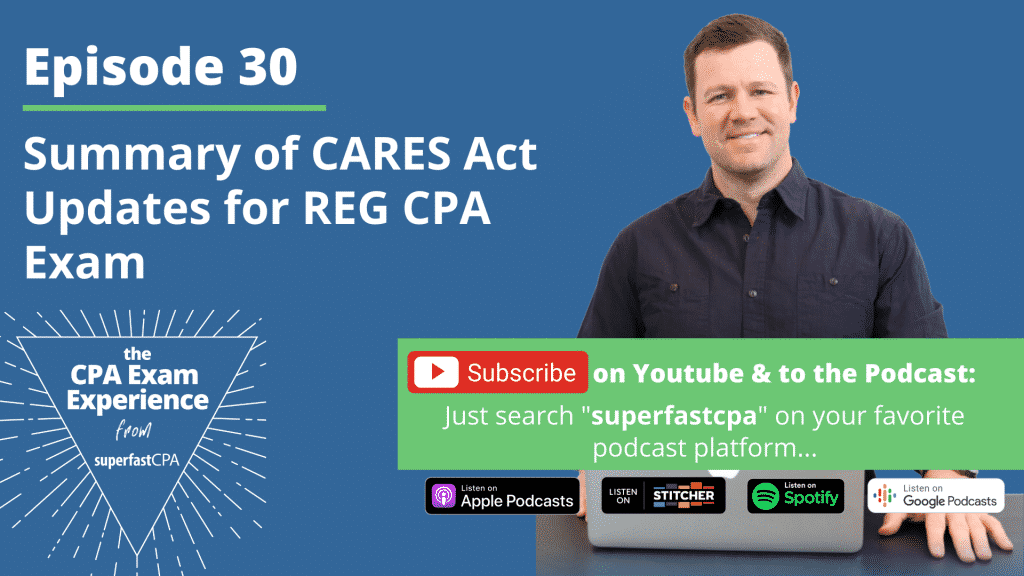The CARES Act, or the Coronavirus Aid, Relief, and Economic Security Act, was passed by Congress to provide aid to individuals and businesses as a result of the economic effects of Coronavirus.
CARES Act Updates for REG CPA Exam in 2020 and 2021
The following changes will be applicable until July 1, 2021 on the REG CPA exam. Below is a summary of the changes, and where applicable the changes have also been added to the relevant portions of the notes.
Personal Tax Credit
Individuals receive a refundable tax credit of $1,200 or $2,400 if married filing jointly, and $500 for each qualifying child. The qualifying child rules are the same as the dependency rules. Most people received this credit as an advance (a check or direct deposit). Nonresident aliens and those claimed as a dependent by another taxpayer do not receive the credit. The credit is also phased down for higher income taxpayers. The credit is reduced by 5% of the difference between the taxpayer’s AGI and the following income levels:
- $150,000 for married filing jointly ($198,000 max)
- $112,500 for head of household ($146,500 max)
- $75,000 filing single ($99,000 max)
For example, if Ken and Stacy are married and file jointly, and they have AGI of $170,000. They would get a credit of $2,400, but they are $20,000 over the $150,000 limit, so the credit is reduced by 5% of $20,000, which is $1,000. So their $2,400 credit would be reduced to $1,400.
Charitable Contributions
Instead of the 60% of AGI for cash contributions, it has been increased to 100% of AGI. For corporate taxpayers, it was increased to 25% from 10%.
$300 Charitable Contribution Deduction
For all taxpayers in tax year 2020 only, there is a $300 deduction for charitable contributions even if the taxpayer uses the standard deduction instead of itemizing. The deduction is $300 total for a tax return – meaning married filing jointly can deduct $300 total, as can an individual taxpayer.
Retirement Plan Early Distributions
The CARES Act allows taxpayers to withdraw up to $100,000 from an IRA that is exempt from the normal 10% penalty, as long as the distribution was taken in 2020 and the distribution was to a qualified taxpayer. A “qualified” taxpayer for a qualifying distribution means the taxpayer:
- Has been diagnosed with Covid-19
- Their spouse or dependent is diagnosed with Covid-19
- Experiences adverse financial consequences as a result of
a. Being quarantined, being furloughed or laid off, or having work hours reduced as a result of Covid-19
b. Being unable to work because due to the lack of childcare as a result of Covid-19
c. Being forced to close or reduce the hours of their trade or business as a result of Covid-19
Also, the distribution can be included in income evenly across 2020, 2021, and 2022.
Also, required minimum distributions are waived for 2020.
HSA-Qualified Expenses
The CARES Act expanded qualified medical expenses for HSAs to include nonprescription drugs and feminine hygiene products.
Tuition Reimbursement Exclusion
Employees can exclude up to $5,250 of employer-provided assistance that was used for undergraduate and graduate tuition, or fees, books, and supplies, or for payments received from their employer that were used to pay the employee’s student loans. The period this exclusion can be applied to are any such payments received between May 28 and December 31, 2020.
Net Operating Loss (NOLs) Rules
Previously, NOLs incurred starting in 2018 could no longer be carried back, but could be carried forward indefinitely. The CARES Act allows NOLs from 2018, 2019, and 2020 to be carried back 5 years, and carried forward indefinitely. Also, when an NOL is applied to tax year 2020, it can offset 100% of taxable income.
SBA Loan Forgiveness
Some SBA loans made between February 15 and June 30, 2020 can be forgiven and excluded from income if the loans were used to retain employees, make interest payments on previous business loans, or to pay lease/rent payments or utility payments incurred before February 15, 2020.
Employee Retention Credit
Employers can claim a tax credit of 50% of wages paid to eligible employees. The credit can be taken in advance by reducing the amount of employment tax deposits made by the employer.
The credit can be taken in any calendar quarter during 2020 when either:
- there was a full or partial suspension of operations of the trade or business due to government orders limiting commerce, travel, or group meetings due to Covid-19, or
- a significant decline in gross receipts
A “significant decline in gross receipts” is defined as at a 50% decline in gross receipts from the same quarter in 2019, and the significant decline ends when gross receipts recover to more than 80% of gross receipts from the same quarter in 2019.
The credit is good for up to $10,000 of wages per employee. If the business averaged more than 100 full-time employees during 2019, then the credit is based on the wages paid to employees that were furloughed or had reduced wages. If the business averaged 100 full- time employees or less during 2019, then the credit is based on the wages paid to all employees.
Excess Business Losses
Losses from a business activity for non- corporate taxpayers had limits on the amount of losses that could offset taxable income. Under the CARES Act, there are no such limitations for business losses incurred in tax years 2018, 2019, and 2020.













